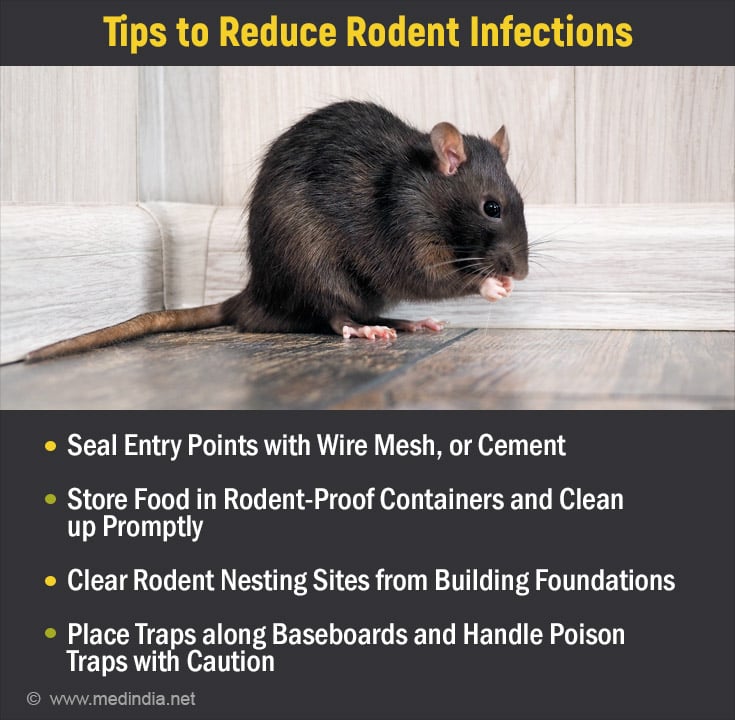- Hantavirus - (https://www.cdc.gov/hantavirus/about/index.html)
- Hantavirus pulmonary syndrome - (https://www.mayoclinic.org/diseases-conditions/hantavirus-pulmonary-syndrome/symptoms-causes/syc-20351838)
About
Hantaviruses have the potential to infect individuals globally and lead to severe illnesses. Transmission typically occurs through exposure to rodents such as rats and mice, particularly via their urine, feces, and saliva. Although less common, hantaviruses can also be spread through bites or scratches from infected rodents.
These viruses are responsible for two distinct syndromes. In the Americas, including the U.S., hantaviruses can lead to Hantavirus Pulmonary Syndrome (HPS). The deer mouse is the primary carrier of the hantavirus and is responsible for HPS in the U.S.
Did You Know?
Hantavirus infections can be life-threatening with a 38% mortality rate in severe cases. #medindia #hantavirus
On the other hand, Hemorrhagic Fever with Renal Syndrome (HFRS) is associated with hantaviruses predominantly found in Europe and Asia. One particular hantavirus, the Seoul virus, which causes HFRS, is also present in the United States.
Symptoms and Signs of Hantavirus
Hantavirus infections, while rare, can be severe and life-threatening, highlighting the importance of understanding and mitigating the risks associated with these viruses.
Hantavirus Pulmonary Syndrome (HPS)
HPS is a severe, potentially life-threatening illness primarily affecting the lungs. Symptoms generally begin 1 to 8 weeks after exposure to an infected rodent. Early indicators include:
- Fatigue
- Fever
- Muscle pain, notably in larger muscle groups like the thighs, hips, back, and occasionally shoulders(1✔ ✔Trusted Source
Hantavirus
Go to source)
Approximately 50% of those with HPS also experience:
After 4 to 10 days, more severe symptoms of HPS may develop, including coughing and difficulty breathing. Patients might also feel chest tightness as their lungs accumulate fluid. HPS can be fatal, with a 38% mortality rate among those who show respiratory symptoms.
Hemorrhagic Fever with Renal Syndrome (HFRS)
HFRS is a severe illness affecting the kidneys, with symptoms usually appearing 1 to 2 weeks after exposure, though in rare cases, it may take up to 8 weeks. Initial symptoms are sudden and may include:
- Severe headaches
- Pain in the back and abdomen
- Fever and chills
- Nausea
- Blurred vision
Additional signs may include:
- Facial flushing
- Eye inflammation or redness
- Rash
Later symptoms of HFRS can involve:
- Low blood pressure
- Acute shock due to insufficient blood flow
- Internal bleeding due to vascular leakage
- Acute kidney failure, leads to significant fluid retention
The severity of HFRS varies by the specific hantavirus involved. Hantaan and Dobrava viruses often cause severe illness, with a 5-15% fatality rate. Conversely, Seoul, Saaremaa, and Puumala viruses usually result in milder cases with less than 1% mortality. Recovery from HFRS can span several weeks to months.
Risk Factors of Hantavirus
Hantavirus pulmonary syndrome is predominantly found in the rural regions of the Western United States, though any contact with rodent habitats can elevate the risk of contracting the disease.
Activities that heighten the risk of hantavirus exposure involve:
- Opening and cleaning buildings that have been unused for long periods
- Handling rodent nests or droppings without taking proper safety measures
- Engaging in work in environments that increase rodent contact, such as construction, utility services, pest control, and agriculture
Diagnosis of Hantavirus
Diagnosing hantavirus infection within the first 72 hours can be challenging. If initial tests are inconclusive, follow-up testing is often necessary 72 hours after symptom onset. Early symptoms like fever, headache, muscle aches, nausea, and fatigue can resemble those of influenza.
A diagnosis of HPS or HFRS is considered if a patient has rodent exposure and symptoms consistent with these conditions. If hantavirus infection is suspected, consult a physician immediately and inform them of any potential rodent contact.
To lower the risk of hantavirus infection, minimize or eliminate contact with rodents in your home, workplace, or campsite. Seal any entry points in your home or garage to prevent rodents from getting inside. Use traps to reduce rodent populations and clean up any easily accessible food that could attract them.
Treatment and Recovery of Hantavirus
There is no specific cure for hantavirus infections. Supportive care is essential, including rest, hydration, and symptom management.
HPS may cause severe breathing difficulties, necessitating breathing support such as intubation, where a tube is placed in the lungs to aid oxygen intake.
HFRS can impair kidney function, requiring dialysis to remove toxins from the blood and manage fluid balance when kidneys are compromised.
Prevention of Hantavirus
To minimize the risk of hantavirus infection, it's essential to keep rodents out of your home and workplace. Follow these strategies:
- Seal Entry Points: Mice can enter through openings as small as 1/4 inch (6 millimeters). Use wire mesh, steel wool, metal flashing, or cement to seal these gaps.
- Manage Food Sources: Clean dishes immediately, wipe down countertops and floors, and store food—including pet food—in rodent-proof containers. Ensure garbage cans have tight-fitting lids.
- Reduce Nesting Sites: Remove brush, grass, and debris from around the building's foundation to minimize potential nesting areas.

- Use Traps: Place spring-loaded traps along baseboards. Be cautious with poison-bait traps, as the poison can also be harmful to people and pets.
- Reposition Yard Items: Relocate woodpiles or compost bins away from the house to deter rodents.
- Ventilate Unused Areas: Before cleaning, ventilate cabins, campers, or seldom-used buildings by opening them up to air out(2✔ ✔Trusted Source
Hantavirus pulmonary syndrome
Go to source).
Conclusion
By staying informed and taking proactive measures, individuals can better protect themselves and others from these potentially dangerous diseases.








